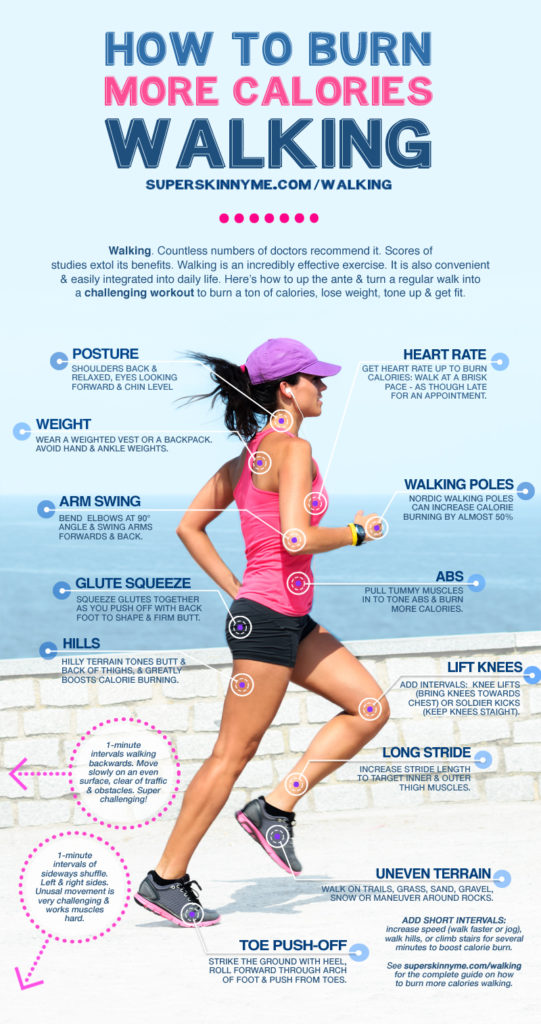Running, spinning, and HIIT workouts might all get the glamor and attention when it comes to losing weight, toning up and getting healthy. However, the humble and simple workout of walking isn’t too shabby either. While walking may not get any of the glory, it sure punches above its weight. Research suggests that weekly walking distance is closely linked to longevity so walk long and live long!
Health Benefits of Walking
“Walking is man’s best medicine”
Hippocrates
Walking for an hour a day can reduce the risk of diabetes, heart disease, blood pressure, stroke, breast cancer, colon cancer, dementia, and even death.1234 Walking can also has a positive effect on mental health and symptoms of depression, can help you sleep better, and improves cognitive function.56
Many other cardiovascular activities boast these health benefits, but the great thing about walking is that you already know how to do it, you need virtually no equipment (bar shoes and clothing), you can do it at any age, it’s super easy on the joints and body, and the risk of injury is incredibly low.7
Indeed a study has suggested that walking is just as good as running at reducing the risk of health issues such as diabetes, high blood pressure, high cholesterol and heart disease! The point is, don’t think of walking as running’s dowdy cousin. Walking is awesome.
Walking to Lose Weight
Walking was something we used to do to get from A to B. Of late the distance between A and B has become rather short. Here’s how to increase that distance again, and do it in a way that you’ll lose weight, get stronger, more fit and improve your health.
Before you start
Walking is a gentle exercise that is natural and safe but if you have been sedentary lately, are significantly overweight, suffer from any medical conditions or are otherwise unsure, please visit your physician and get a checkup before you start exercising.
The right gear. Once you have been given the ok, make sure the shoes you intend to wear walking are supportive, with good arch support, cushioned and comfortable. Your socks should be free of seams and holes, and the clothes you intend to wear should be cool and comfortable.
Your walking routine. As with any exercise routine, remember to:
- Warm-up. Start by walking slowly for 5 -10 minutes. This will warm up your muscles and prepare your body for exercise.
- Cool-down. Don’t stop exercising abruptly. At the end of your walk, slow down for 5 – 10 minutes. This will allow your muscles to cool down.
- Stretch. After your cool down, gently stretch your muscles.
Start Easy
It’s all too easy to let your enthusiasm run away from you and walk too far, too soon. This can leave you sore, tired and disillusioned; none of which will help you develop a long term walking habit. Instead, keep your walk short and then call it a day.
If everything went well, add another minute or two to your next walk. Again, if you are feeling fine, add a couple more minutes to your next walk. Continue adding a minute or two to your walks until you can comfortably walk for 30 – 60 minutes.
To walk comfortably, further, and faster walk with good posture. Poor walking technique can slow you down, result in discomfort, or cause you to tire prematurely. Walking tall is a simple way to correct a variety of posture issues.

How to Walk with Good Posture
Learn to how to walk briskly with good posture and technique, so that you can walk further, faster, and prevent discomfort.
How Fast to Walk for Weight Loss?
To lose weight walking, aim for 30 – 60 minutes at a brisk pace, or if you’re very fit a power-walk pace. Walking briskly isn’t just about weight loss. You need to walk at a pace of at least that of a brisk walk to reap significant health benefits from walking.8910
Instead of going for one long walk, you can go for several shorter walks throughout the day (e.g. three 10-minutes walks, two 30-minute walks). Research shows this to be at least as effective for weight loss.111213
So, how fast are a stroll, brisk walk and power walk?
Stroll/ leisurely walking speed. This is a pace of about 2 miles per hour (mph).14 It is a window-shopping type pace and low-intensity exercise. On the RPE scale it’s an intensity of about 4 out of 10.
Brisk walking speed. According to the CDC a brisk pace is 2.5 to 4 mph, depending on your level of fitness.14 Recent research further suggests that on average, for a healthy person under the age of 60, a brisk pace is about 3 mph or 100 steps per minute.15 It’s a pace you might walk at when you’re walking fast because you’re running late for an appointment. On the RPE scale this is an intensity of 5 – 6 on a scale of 10, which is a moderate-intensity workout. Heart rate target is about 65-75% of your maximum heart rate. You can carry on a conversation, but will need to catch your breath every few sentences.
Power walk speed. According to the CDC walking at high-intensity equates to a pace of 4.5 to 5 mph.14 For a healthy person under the age of 60 this is roughly above 130 steps per minute.15 You’re burning a lot of calories at this level. On the RPE scale it’s about a 7 or 8 out of 10. This is high-intensity exercise, you can still talk, but only in short spurts of three or four words.
Below is a rough guide of how many calories you’ll burn when walking at different speeds for different body weights.
| Walking Speed/ Weight | 120 lbs | 140 lbs | 160 lbs | 180 lbs | 200 lbs |
|---|---|---|---|---|---|
| 2.0 mph (30 min/ mile) | 68 | 79 | 91 | 102 | 113 |
| 2.5 mph (24 min/ mile) | 82 | 95 | 109 | 122 | 136 |
| 3.0 mph (20 min/ mile) | 90 | 105 | 120 | 135 | 150 |
| 3.5 mph (17 min/ mile) | 103 | 121 | 138 | 155 | 172 |
| 4.0 mph (15 min/ mile) | 136 | 159 | 181 | 204 | 227 |
| 4.5 mph (13min/ mile) | 171 | 200 | 229 | 257 | 286 |
| 5.0 mph (12 min/ mile) | 218 | 254 | 290 | 327 | 363 |
How Long Should You Walk Each Day?
Aim to walk continuously for 30 – 60 minutes most days of the week to lose weight walking. If you walk at a brisk pace for 30 minutes, you’ll cover a distance of about 1½ to 2 miles (2.5 to 3.3 kilometers). Take the distance into consideration when planning your walking route.
According to the Centers for Disease Control (CDC), to lose more than 5% of body weight and to keep it off, you may need to do at least 300 minutes of moderate-intensity activity a week (or 150 minutes of high-intensity exercise).16 That’s about 40 minutes of brisk walking every day, or 60 minutes of walking briskly 5 days a week.
Try to include other activities, such as strength training or Pilates, especially on days you’re not walking. However, if you feel worn out, take a day off to recuperate and resume your walking schedule the next day.
Making Progress
When you lose weight your body burns fewer calories. This means you need fewer calories per day (recalculate your daily calorie requirements) and you burn less calories when you exercise (take another look at the table above, showing how calories burned walking varies with body weight).1718 Therefore, to keep losing weight slowly make your walks a little more challenging.
Once you are able to walk 30 – 60 minutes, it’s time to make things more challenging. Unless you have unconstrained free time, there will be a limit to how much time you can spend walking each day. For most people, 60-minutes is probably a reasonable maximum. Instead of walking further and further, there are several other things you can do to keep improving your fitness and help weight loss.
These are some ways you can increase the intensity of your walks:
- Walk faster. Try to shave a minute or two off the time it normally takes you to complete your walk
- Walk more often. If you normally walk three times a week, add an extra walk to make it four. A few weeks later, add another walk to make it five. Try and work up to seven walks per week. You can also walk more than once per day.
- Seek out hills and rough terrain. Walking on flat, paved paths is fine but getting off road or heading up hill will make your workouts more demanding. And more demanding workout means you burn more calories.

How to Burn More Calories Walking (+ Calculator)
Learn how to increase the calories burned walking with this easy guide. Plus use the walking calorie calculator to find out how many calories you burn walking.
Remember Your Diet
Whether you are walking for fitness or fat loss, your diet should match your exercise goals. You don’t have to follow some crazy fad diet to lose weight and get fit – just make sure you create a moderate calorie deficit and eat a healthy, balance diet with an abundance of good old fashioned natural food.
Eat plenty of vegetables, whole grains, lean protein, healthy oils, nuts and seeds and some fruit and try to consume these foods in their most natural state.
Use this tool: Weight loss calorie calculator
Walking Challenge
One of the best ways to get into walking is to make it a habit. Habits can take a while to develop and this challenge has worked for many people.
Simply walk for 30-minutes every day for 30-days straight. For this “30 minutes for 30 days” challenge don’t do any other exercise other than a some stretching to keep your muscles supple.
You can walk the whole 30-minutes in a single session, do three 10-minute walks spread throughout the day, or follow the interval walking workout below to get started.
Warm-up before this workout and cool down after by walking at an easy pace (RPE 3-4) for 5 minutes.
Interval Walking Workout
| Interval training is a type a workout in which you alternate between harder bouts of exercise (called work intervals) and easier bouts of exercise that give you time to recover (called recovery intervals). This method allows you to exercise for longer and is easier for beginners. Simply alternate between 3 minutes of brisk walking and 2 minutes of walking at a slower pace. Repeat this cycle 6 times. This is summarized below: |
| Work | 3 min brisk walking (RPE 5-6)* |
| Recovery | 2 min easier walking (RPE 3-4) |
| Complete cycle 6 times |
| *If you already walk briskly regularly, you can make this workout harder by power walking instead (RPE 7-8). |
By walking every day, you give your fitness and weight loss a great kick start and by the end of the month you will have made daily walking a habit.

Beginner Run/ Walk Plan
Learn how to run with this easy beginner’s run-walk plan. Go from 0 to running 30 minutes continuously in just 10 weeks.
What should you do at the end of the month? Keep going! Up the ante and do 40-days/40-minutes. After that, why not 50-days/50-minutes? Or consider this beginners running plan, which uses an interval training method similar to the workout above, to take you from walking to running 30 minutes continuously. Whatever you do, just keep going!

